Ram 1500 2009 Owner's Manual
Manufacturer: RAM, Model Year: 2009, Model line: 1500, Model: Ram 1500 2009Pages: 543, PDF Size: 7.75 MB
Page 431 of 543
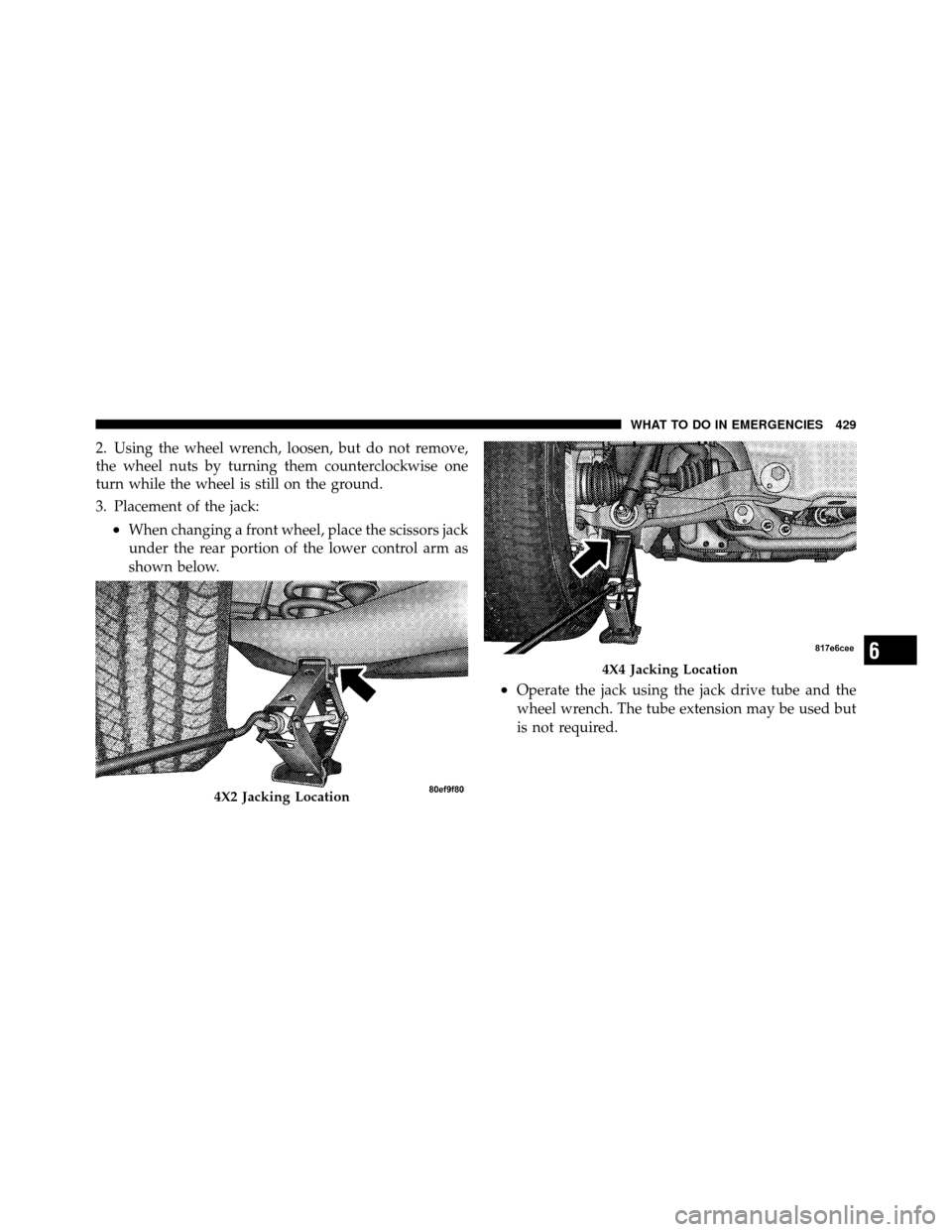
2. Using the wheel wrench, loosen, but do not remove,
the wheel nuts by turning them counterclockwise one
turn while the wheel is still on the ground.
3. Placement of the jack:
•When changing a front wheel, place the scissors jack
under the rear portion of the lower control arm as
shown below.
•Operate the jack using the jack drive tube and the
wheel wrench. The tube extension may be used but
is not required.
4X2 Jacking Location
4X4 Jacking Location6
WHAT TO DO IN EMERGENCIES 429
Page 432 of 543
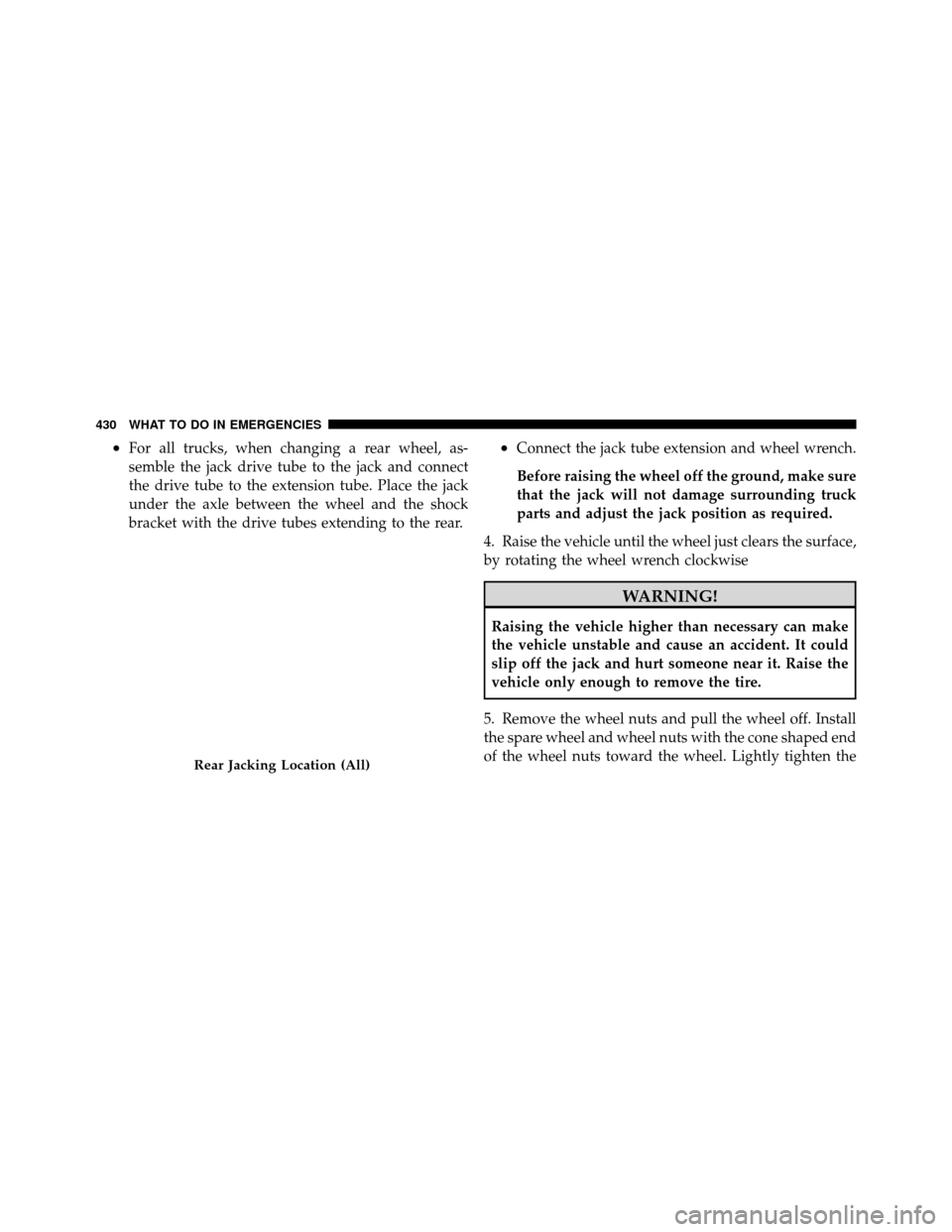
•For all trucks, when changing a rear wheel, as-
semble the jack drive tube to the jack and connect
the drive tube to the extension tube. Place the jack
under the axle between the wheel and the shock
bracket with the drive tubes extending to the rear.•Connect the jack tube extension and wheel wrench.
Before raising the wheel off the ground, make sure
that the jack will not damage surrounding truck
parts and adjust the jack position as required.
4. Raise the vehicle until the wheel just clears the surface,
by rotating the wheel wrench clockwise
WARNING!
Raising the vehicle higher than necessary can make
the vehicle unstable and cause an accident. It could
slip off the jack and hurt someone near it. Raise the
vehicle only enough to remove the tire.
5. Remove the wheel nuts and pull the wheel off. Install
the spare wheel and wheel nuts with the cone shaped end
of the wheel nuts toward the wheel. Lightly tighten the
Rear Jacking Location (All)
430 WHAT TO DO IN EMERGENCIES
Page 433 of 543
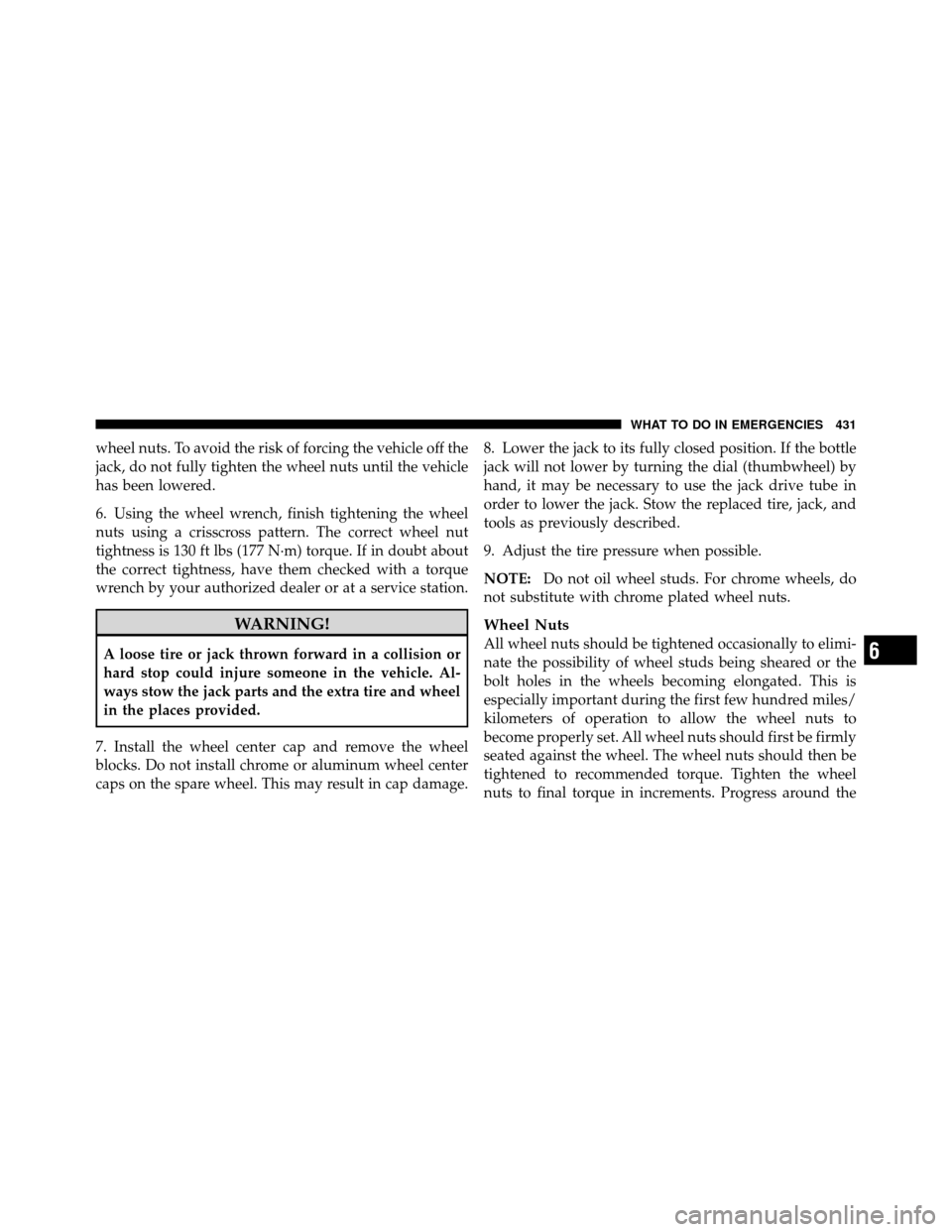
wheel nuts. To avoid the risk of forcing the vehicle off the
jack, do not fully tighten the wheel nuts until the vehicle
has been lowered.
6. Using the wheel wrench, finish tightening the wheel
nuts using a crisscross pattern. The correct wheel nut
tightness is 130 ft lbs (177 N·m) torque. If in doubt about
the correct tightness, have them checked with a torque
wrench by your authorized dealer or at a service station.
WARNING!
A loose tire or jack thrown forward in a collision or
hard stop could injure someone in the vehicle. Al-
ways stow the jack parts and the extra tire and wheel
in the places provided.
7. Install the wheel center cap and remove the wheel
blocks. Do not install chrome or aluminum wheel center
caps on the spare wheel. This may result in cap damage. 8. Lower the jack to its fully closed position. If the bottle
jack will not lower by turning the dial (thumbwheel) by
hand, it may be necessary to use the jack drive tube in
order to lower the jack. Stow the replaced tire, jack, and
tools as previously described.
9. Adjust the tire pressure when possible.
NOTE:
Do not oil wheel studs. For chrome wheels, do
not substitute with chrome plated wheel nuts.
Wheel Nuts
All wheel nuts should be tightened occasionally to elimi-
nate the possibility of wheel studs being sheared or the
bolt holes in the wheels becoming elongated. This is
especially important during the first few hundred miles/
kilometers of operation to allow the wheel nuts to
become properly set. All wheel nuts should first be firmly
seated against the wheel. The wheel nuts should then be
tightened to recommended torque. Tighten the wheel
nuts to final torque in increments. Progress around the6
WHAT TO DO IN EMERGENCIES 431
Page 434 of 543
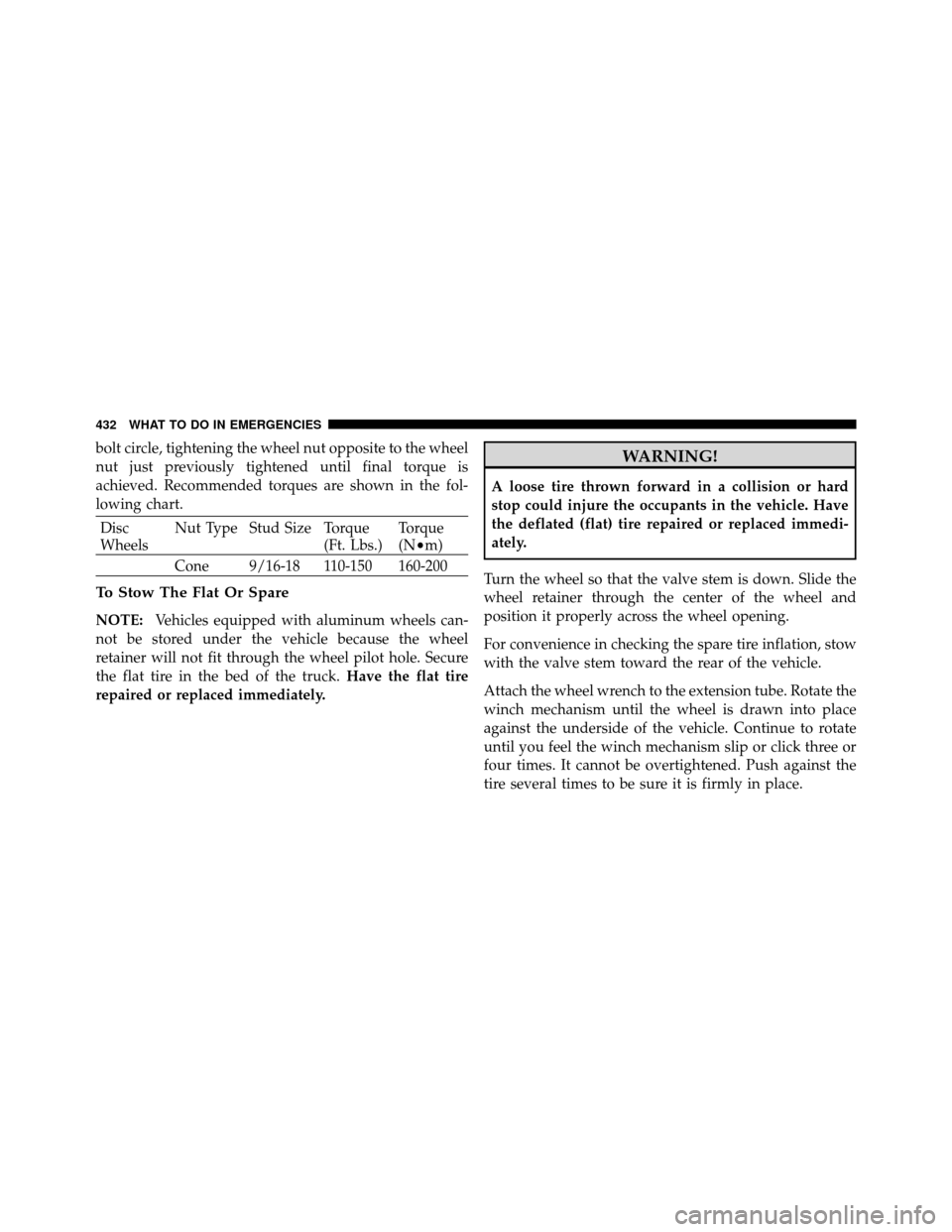
bolt circle, tightening the wheel nut opposite to the wheel
nut just previously tightened until final torque is
achieved. Recommended torques are shown in the fol-
lowing chart.
Disc
WheelsNut Type Stud Size Torque
(Ft. Lbs.)Torque
(N•m)
Cone 9/16-18 110-150 160-200
To Stow The Flat Or Spare
NOTE: Vehicles equipped with aluminum wheels can-
not be stored under the vehicle because the wheel
retainer will not fit through the wheel pilot hole. Secure
the flat tire in the bed of the truck. Have the flat tire
repaired or replaced immediately.
WARNING!
A loose tire thrown forward in a collision or hard
stop could injure the occupants in the vehicle. Have
the deflated (flat) tire repaired or replaced immedi-
ately.
Turn the wheel so that the valve stem is down. Slide the
wheel retainer through the center of the wheel and
position it properly across the wheel opening.
For convenience in checking the spare tire inflation, stow
with the valve stem toward the rear of the vehicle.
Attach the wheel wrench to the extension tube. Rotate the
winch mechanism until the wheel is drawn into place
against the underside of the vehicle. Continue to rotate
until you feel the winch mechanism slip or click three or
four times. It cannot be overtightened. Push against the
tire several times to be sure it is firmly in place.
432 WHAT TO DO IN EMERGENCIES
Page 435 of 543
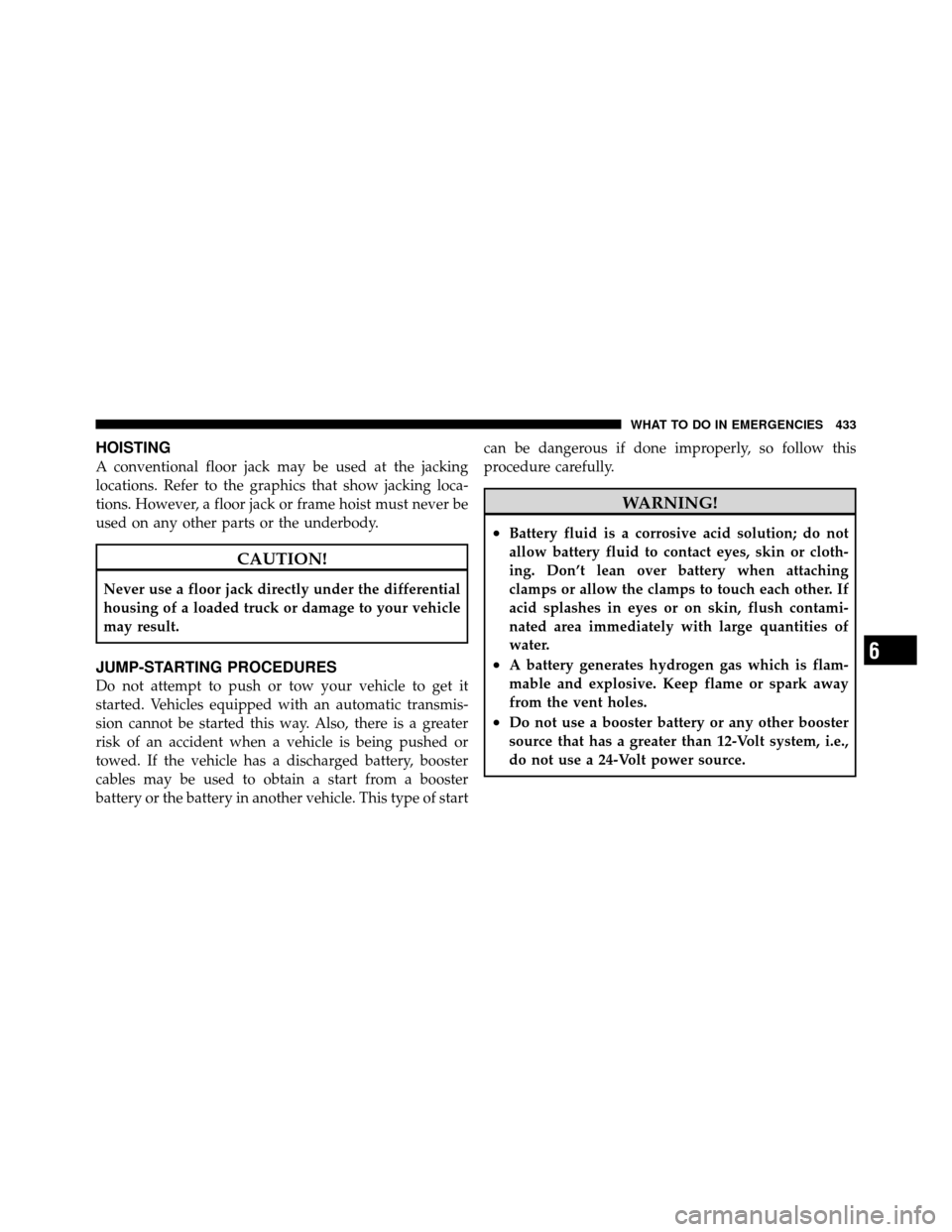
HOISTING
A conventional floor jack may be used at the jacking
locations. Refer to the graphics that show jacking loca-
tions. However, a floor jack or frame hoist must never be
used on any other parts or the underbody.
CAUTION!
Never use a floor jack directly under the differential
housing of a loaded truck or damage to your vehicle
may result.
JUMP-STARTING PROCEDURES
Do not attempt to push or tow your vehicle to get it
started. Vehicles equipped with an automatic transmis-
sion cannot be started this way. Also, there is a greater
risk of an accident when a vehicle is being pushed or
towed. If the vehicle has a discharged battery, booster
cables may be used to obtain a start from a booster
battery or the battery in another vehicle. This type of startcan be dangerous if done improperly, so follow this
procedure carefully.
WARNING!
•Battery fluid is a corrosive acid solution; do not
allow battery fluid to contact eyes, skin or cloth-
ing. Don’t lean over battery when attaching
clamps or allow the clamps to touch each other. If
acid splashes in eyes or on skin, flush contami-
nated area immediately with large quantities of
water.
•A battery generates hydrogen gas which is flam-
mable and explosive. Keep flame or spark away
from the vent holes.
•Do not use a booster battery or any other booster
source that has a greater than 12-Volt system, i.e.,
do not use a 24-Volt power source.
6
WHAT TO DO IN EMERGENCIES 433
Page 436 of 543
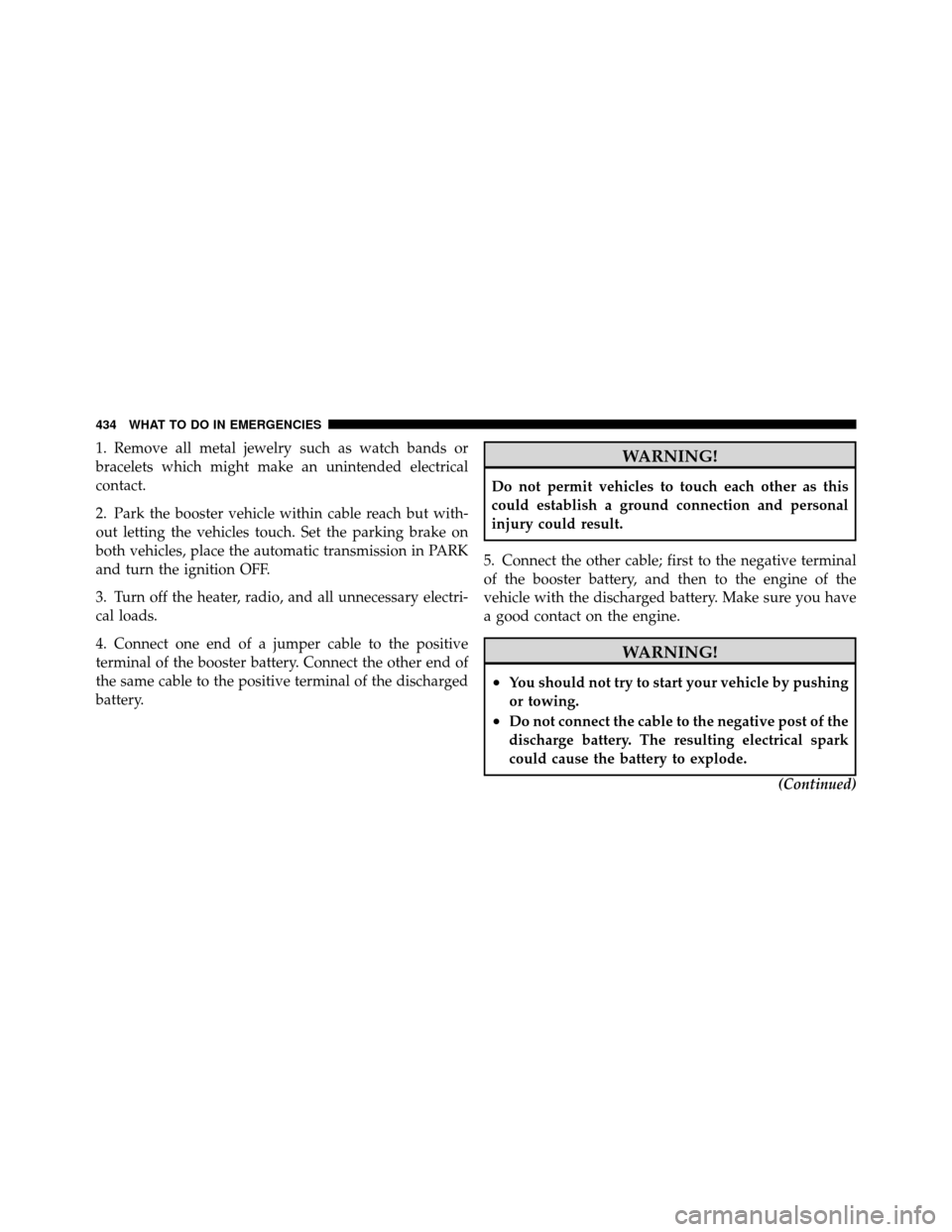
1. Remove all metal jewelry such as watch bands or
bracelets which might make an unintended electrical
contact.
2. Park the booster vehicle within cable reach but with-
out letting the vehicles touch. Set the parking brake on
both vehicles, place the automatic transmission in PARK
and turn the ignition OFF.
3. Turn off the heater, radio, and all unnecessary electri-
cal loads.
4. Connect one end of a jumper cable to the positive
terminal of the booster battery. Connect the other end of
the same cable to the positive terminal of the discharged
battery.WARNING!
Do not permit vehicles to touch each other as this
could establish a ground connection and personal
injury could result.
5. Connect the other cable; first to the negative terminal
of the booster battery, and then to the engine of the
vehicle with the discharged battery. Make sure you have
a good contact on the engine.
WARNING!
•You should not try to start your vehicle by pushing
or towing.
•Do not connect the cable to the negative post of the
discharge battery. The resulting electrical spark
could cause the battery to explode. (Continued)
434 WHAT TO DO IN EMERGENCIES
Page 437 of 543
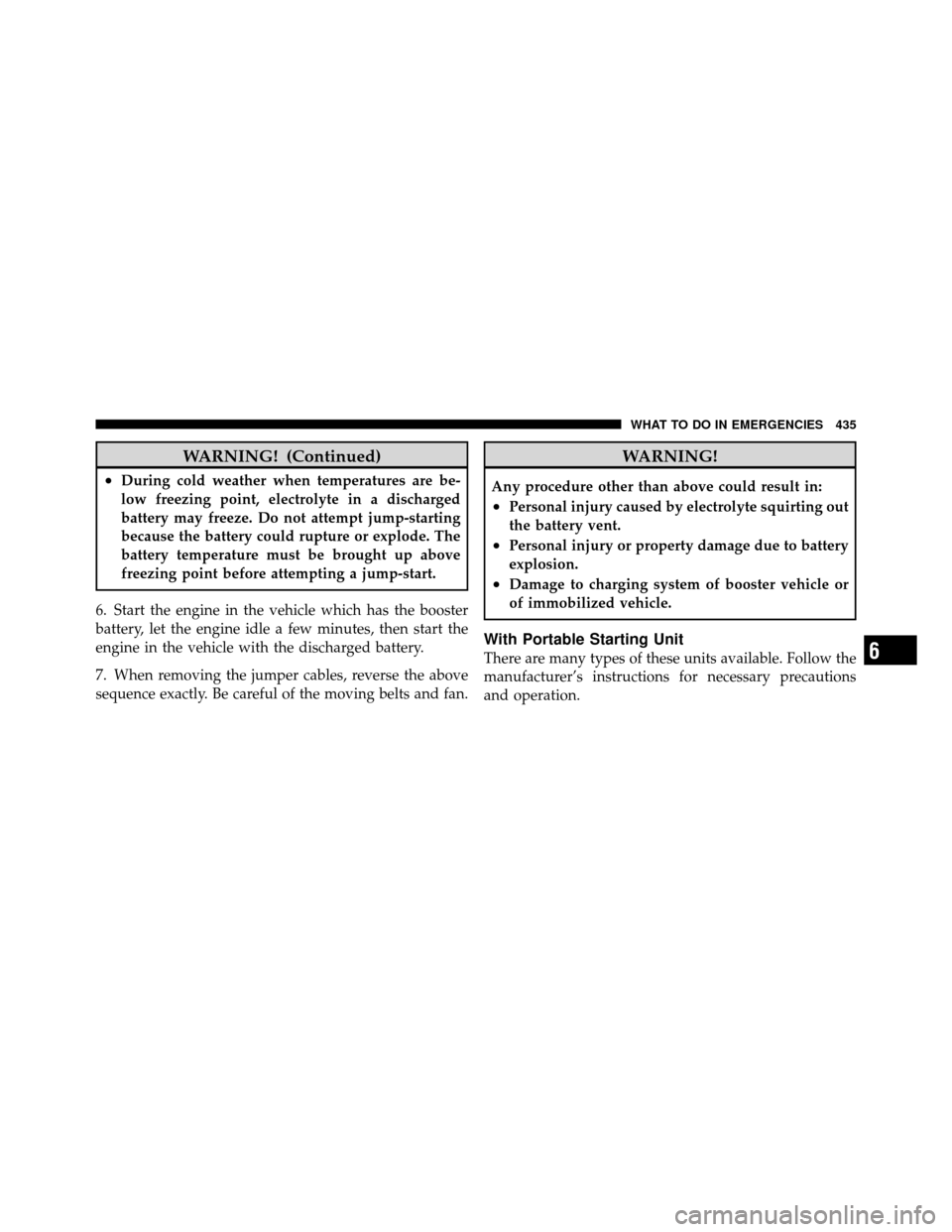
WARNING! (Continued)
•During cold weather when temperatures are be-
low freezing point, electrolyte in a discharged
battery may freeze. Do not attempt jump-starting
because the battery could rupture or explode. The
battery temperature must be brought up above
freezing point before attempting a jump-start.
6. Start the engine in the vehicle which has the booster
battery, let the engine idle a few minutes, then start the
engine in the vehicle with the discharged battery.
7. When removing the jumper cables, reverse the above
sequence exactly. Be careful of the moving belts and fan.
WARNING!
Any procedure other than above could result in:
•Personal injury caused by electrolyte squirting out
the battery vent.
•Personal injury or property damage due to battery
explosion.
•Damage to charging system of booster vehicle or
of immobilized vehicle.
With Portable Starting Unit
There are many types of these units available. Follow the
manufacturer’s instructions for necessary precautions
and operation.6
WHAT TO DO IN EMERGENCIES 435
Page 438 of 543
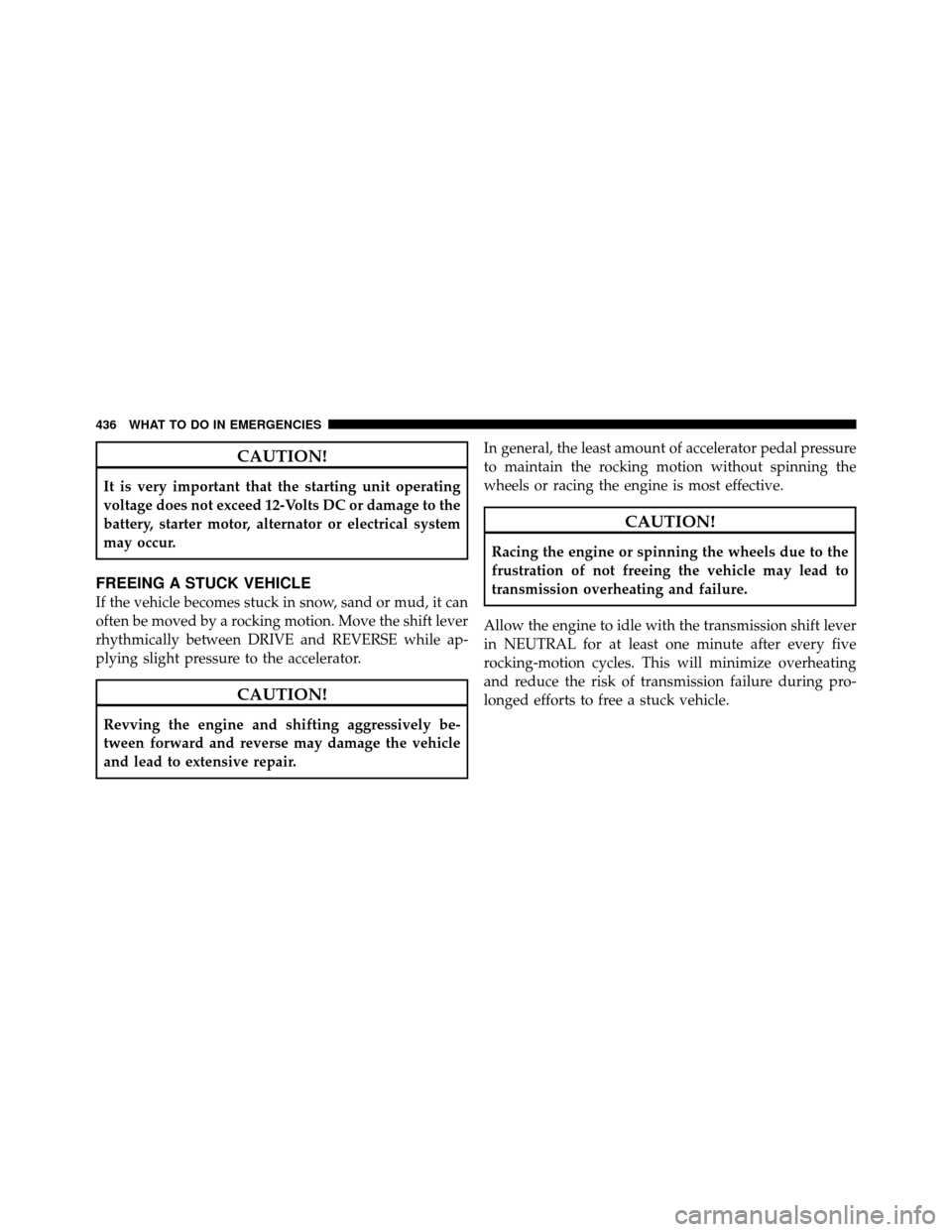
CAUTION!
It is very important that the starting unit operating
voltage does not exceed 12-Volts DC or damage to the
battery, starter motor, alternator or electrical system
may occur.
FREEING A STUCK VEHICLE
If the vehicle becomes stuck in snow, sand or mud, it can
often be moved by a rocking motion. Move the shift lever
rhythmically between DRIVE and REVERSE while ap-
plying slight pressure to the accelerator.
CAUTION!
Revving the engine and shifting aggressively be-
tween forward and reverse may damage the vehicle
and lead to extensive repair.In general, the least amount of accelerator pedal pressure
to maintain the rocking motion without spinning the
wheels or racing the engine is most effective.
CAUTION!
Racing the engine or spinning the wheels due to the
frustration of not freeing the vehicle may lead to
transmission overheating and failure.
Allow the engine to idle with the transmission shift lever
in NEUTRAL for at least one minute after every five
rocking-motion cycles. This will minimize overheating
and reduce the risk of transmission failure during pro-
longed efforts to free a stuck vehicle.
436 WHAT TO DO IN EMERGENCIES
Page 439 of 543
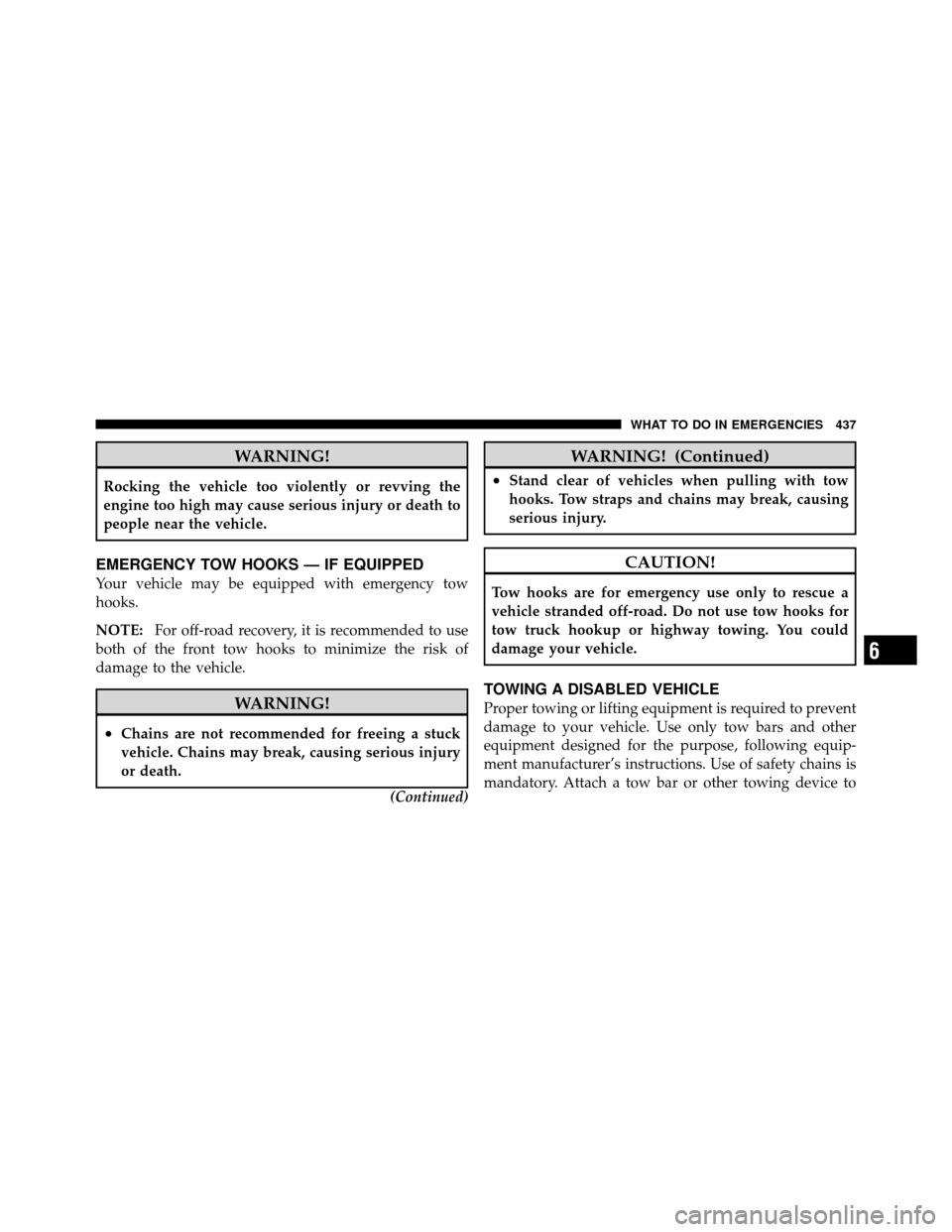
WARNING!
Rocking the vehicle too violently or revving the
engine too high may cause serious injury or death to
people near the vehicle.
EMERGENCY TOW HOOKS — IF EQUIPPED
Your vehicle may be equipped with emergency tow
hooks.
NOTE:For off-road recovery, it is recommended to use
both of the front tow hooks to minimize the risk of
damage to the vehicle.
WARNING!
•Chains are not recommended for freeing a stuck
vehicle. Chains may break, causing serious injury
or death.
(Continued)
WARNING! (Continued)
•Stand clear of vehicles when pulling with tow
hooks. Tow straps and chains may break, causing
serious injury.
CAUTION!
Tow hooks are for emergency use only to rescue a
vehicle stranded off-road. Do not use tow hooks for
tow truck hookup or highway towing. You could
damage your vehicle.
TOWING A DISABLED VEHICLE
Proper towing or lifting equipment is required to prevent
damage to your vehicle. Use only tow bars and other
equipment designed for the purpose, following equip-
ment manufacturer’s instructions. Use of safety chains is
mandatory. Attach a tow bar or other towing device to
6
WHAT TO DO IN EMERGENCIES 437
Page 440 of 543
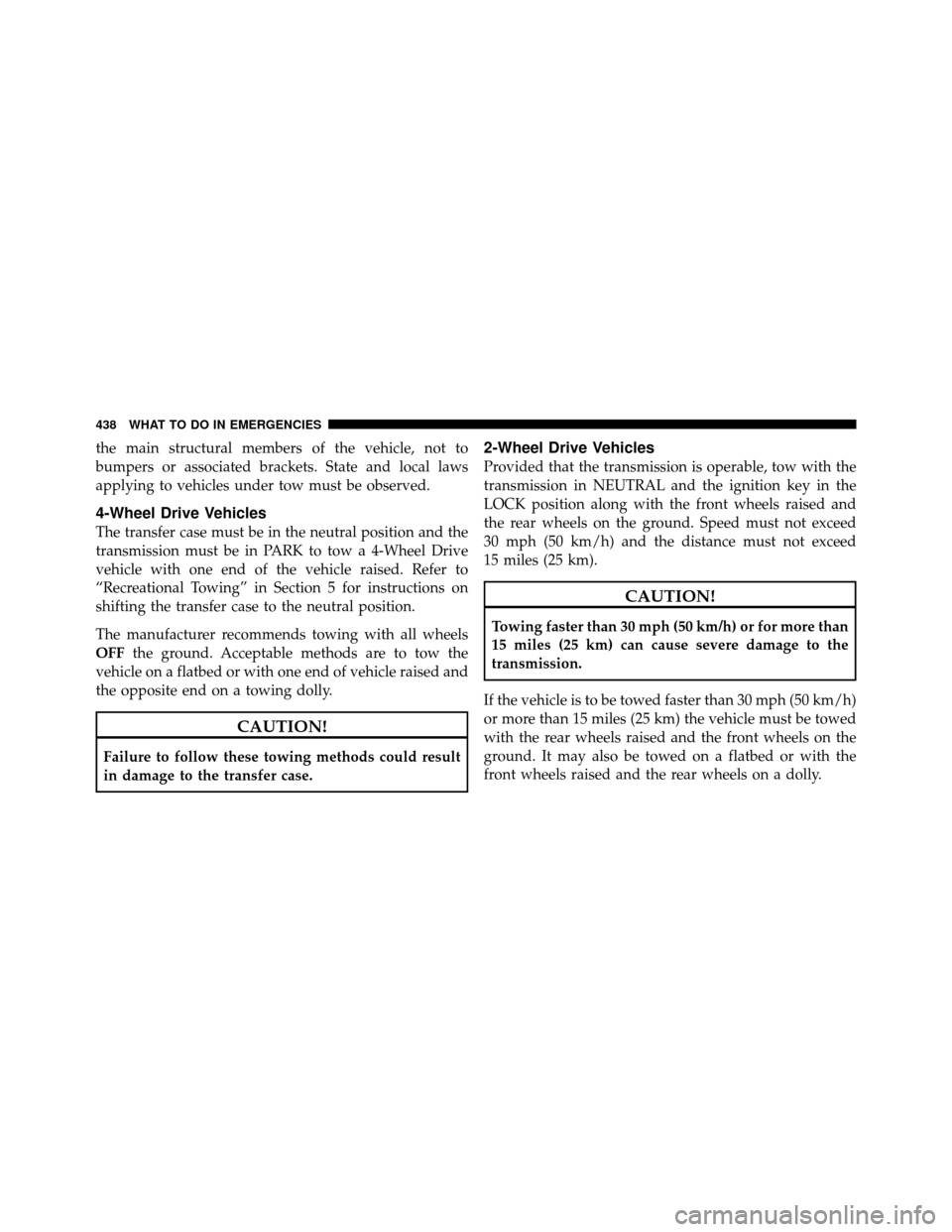
the main structural members of the vehicle, not to
bumpers or associated brackets. State and local laws
applying to vehicles under tow must be observed.
4-Wheel Drive Vehicles
The transfer case must be in the neutral position and the
transmission must be in PARK to tow a 4-Wheel Drive
vehicle with one end of the vehicle raised. Refer to
“Recreational Towing” in Section 5 for instructions on
shifting the transfer case to the neutral position.
The manufacturer recommends towing with all wheels
OFFthe ground. Acceptable methods are to tow the
vehicle on a flatbed or with one end of vehicle raised and
the opposite end on a towing dolly.
CAUTION!
Failure to follow these towing methods could result
in damage to the transfer case.
2-Wheel Drive Vehicles
Provided that the transmission is operable, tow with the
transmission in NEUTRAL and the ignition key in the
LOCK position along with the front wheels raised and
the rear wheels on the ground. Speed must not exceed
30 mph (50 km/h) and the distance must not exceed
15 miles (25 km).
CAUTION!
Towing faster than 30 mph (50 km/h) or for more than
15 miles (25 km) can cause severe damage to the
transmission.
If the vehicle is to be towed faster than 30 mph (50 km/h)
or more than 15 miles (25 km) the vehicle must be towed
with the rear wheels raised and the front wheels on the
ground. It may also be towed on a flatbed or with the
front wheels raised and the rear wheels on a dolly.
438 WHAT TO DO IN EMERGENCIES